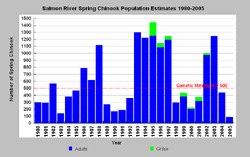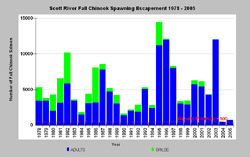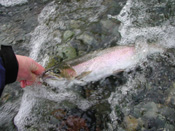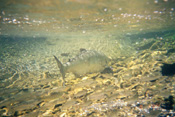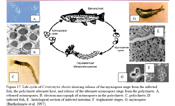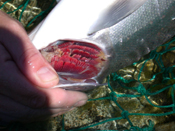Klamath River Fish Health and Disease
- Disease organisms in the Klamath River are more likely to cause epidemics when fish are stressed.
- High water temperature, low dissolved oxygen, high pH (alkalinity) and unionized ammonia in the mainstem Klamath River create stressful conditions for salmonids.
- Fish collected in the mainstem Klamath River have higher rates of disease than fish in tributaries, where water quality is better.
- High nutrients below Iron Gate Dam stimulate the growth of beds of the attached algal species Cladophora, which provides habitat for the intermediate host (a polychaete worm) of Ceratomyxa shasta. C. shasta has been responsible for most of the mortality of Klamath River juvenile salmonids in recent years.
- The toxic algae Microcystis aeruginosa is found in KHP reservoirs and the species and its toxins have been measured all the way to the mouth of the Klamath River. Its effects on fish have not yet been determined.
- FERC acknowledges that removal of KHP Dams would 1) reduce nutrient pollution that contributes to fish health problems, 2) reduce disease host and C. shasta spores, and 3) relieve temperature problems for fall chinook salmon spawning and rearing attributable to Iron Gate Reservoir.
Note: this page has not been updated for several years. More recent info is available on the web pages of the Oregon State University Salmon Disease Lab (Klamath River Salmon Page) and the U.S. Fish and Wildlife Service California-Nevada Fish Health Center
Stressful water quality conditions weaken fish
The Klamath River is home to a number of Pacific salmon species that are important to Klamath Basin Indian Tribes. Spring- and fall-run chinook, summer and winter steelhead, coho salmon and coastal cutthroat trout use the river every day of the year while rearing or migrating to the ocean, and on spawning journeys back to their native streams. Many eggs are also laid in the river's bed. Salmonids are very sensitive to water pollution and sensitivity may vary during the different stages of their lives.
Many fish disease organisms occur naturally in the Klamath River (Stocking and Bartholomew, 2005). Since native fish have co-evolved with them, they can carry these diseases at less than lethal levels (Kier Associates, 1991; Walker and Foott, 1993; Foott et al. 2003). When water quality deteriorates, diminished flows cause crowding and stress, or when parasite spore loads are extremely high, then lethal disease outbreaks can occur (Spence et al., 1996; Guillen, 2003; CDFG, 2003; Yurok Tribe, 2004; Foott, 1995; Nichols and Foott, 2005).
Water quality conditions in the mainstem Klamath River caused by upstream diversions and hydropower operations can be highly stressful for salmonids due to increased stream temperatures, depressed dissolved oxygen, high pH and episodes of nutrient-caused unionized ammonia formation (QVIC, 2006).
Water temperature is a major stress for Klamath River salmonids, particularly during summer juvenile rearing periods and late-summer and early fall adult migrations (Kier Associates, 1999; CDFG, 2003). Maximums often reach 25 degrees C, which is recognized as lethal for most Pacific salmon by Sullivan et al. (2000). The U.S. EPA (2003) recommends temperatures below 21 degrees C for adult salmon migration. See KHP & Water Pollution page for more on temperature problems below Iron Gate Reservoir.
Dissolved oxygen (D.O.): Spence et al. (1996) recognized 3.3 mg/l as a lethal dissolved oxygen level for salmonids, but also noted that D.O. levels of 5 mg/l reduced growth.
pH: Wilkie and Wood (1995) found that a pH greater than 9.6 was lethal to salmonids and that a pH over 8.5 could cause chronic stress and exhaustion. The effect of high pH in combination with high water temperature increases unionized ammonia, which is highly toxic to salmon and steelhead.
Unionized ammonia: The U.S. Environmental Protection Agency (U.S. EPA, 1986) that lethal levels for dissolved or unionized ammonia for salmonids ranged from 0.083 to 1.09 mg/L. Sub-lethal effects of unionized ammonia may be considerable as ammonia tends to travel across the gill membrane and create an imbalance of ammonia in the fish's blood.
Mycrocystin toxins: The Karuk Tribe and Dr. Jacob Kann identified the toxic blue-green algae species Microcystis aeruginosa in Copco and Iron Gate Reservoirs (see Toxic Algae). The Yurok Tribe and U.S. Fish and Wildlife Service found Microcystis and related toxins below KHP reservoirs and in the Klamath River, all the way to the estuary (YTEP, 2006). Bioassays found traces of Microcystin toxins, which are highly toxic for salmonids, in Klamath River steelhead livers.
Combined factors: Spence et al. (1996) noted that: "physiological responses to ammonia exposure are frequently exacerbated by low dissolved oxygen concentrations; for salmonids acute toxicity is increased twofold when D.O. is decreased from 80% to 30% saturation. Thus, water quality factors may interact as fish stressors leading to direct mortality or increased susceptibility to disease."
Prevalence and types of fish diseases in the Klamath
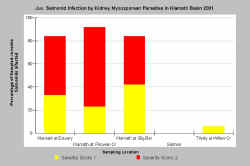 |
|
| This chart shows levels of infection by severity of Klamath, Salmon and Trinity river juvenile salmonids in 2001. Data from Foott et al. (2002). Chart from KRIS V 3.0. |
Disease data collected in the Klamath, Salmon and Trinity rivers in 2001 by the U.S. Fish and Wildlife Fish Health Center showed that Klamath River juvenile salmonids were much more susceptible to protozoan kidney parasites than those in the Salmon and Trinity, which have much better water quality (Foott et al., 2002). Salmonids use their kidney to maintain salt balance and other critical blood chemistry parameters.
Nichols and Foott (2005) found that juvenile chinook salmon downstream migrants in the Klamath River in summer 2004 had high incidences of both Ceratomyxa shasta (45%) and Parvicapsula minibicornis (94%), and that the fish which were infected with C. shasta would not likely survive to adulthood.
Stocking and Bartholomew (2004) and Stocking (2006) provide key information regarding C. shasta one, of the Klamath River's most deadly disease organisms. C. shasta's intermediate host organism is the polychaete worm Manayunkia speciosa. The worm's primary habitat is organic matter in fine bottom sands and its secondary habitat is dense beds of Cladophora, a filamentous green algal species that thrives in nutrient-rich waters. Due to excessive concentrations of organic matter and nutrients, caused in part by KHP reservoirs, both these habitat types are abundant below Iron Gate reservoir. The abundant organic matter grows huge numbers of the polychaete worm, which become infected with C. shasta and, in turn, release prodigious amounts of C. shasta spores into the water, which produces the high rates of C. shasta infection in the river's juvenile salmonids.
Scientists have developed genetic methods to measure the concentrations of C. shasta spores in the water samples (Hallet and Bartholomew, 2006), and then have used sentinel fish studies to relate spore concentrations to fish mortality risk (Bartholomew 2008). Approximately 10 spores per liter appears to be a threshold for mortality in juvenile Chinook salmon; when less than this number are detected, cumulative mortality is 10% or less, whereas when this value is exceeded, cumulative mortality is 30% and above. In 2007, the reach with the highest concentrations of spores was downstream of Iron Gate Dam between Interstate 5 and Seiad Valley (Bartholomew, 2008). Correspondingly, studies have found that the sites with the highest percent of polychaetes infected with C. shasta are Interstate 5 and Tree of Heaven (Stocking 2006), in the upper end of that same reach. These high infection rates have been attributed to Iron Gate Dam, which blocks upstream migration and thus thousands of salmon spawn in a confined area, die, and then release spores that infect the polychaetes (Stocking and Bartholomew 2007).
Ichthyophthirius multifiliis or Ich, a protozoan, and Flavobacterium columnare or Columnaris, bacteria, are two common fish diseases that were implicated in the lower Klamath in massive kill of adult salmon in the lower Klamath River in September 2002 (CDFG, 2003; Guillen, 2003). The Yurok Tribe (2004) have described how high water temperatures, combined with flows lowered to less than 1,000 cubic feet per second from Iron Gate Dam, contribute to fish crowding, increased stress, disease transmission and resulting mortality.
Status of Klamath salmon populations
Pacific salmon researchers have discovered that there are cycles of approximately 25 years associated with ocean currents and precipitation that alternate between favorable for Washington, Oregon and California salmon and steelhead populations and, then, switch to favor stocks in Alaska and Canada (Hare et al. 1999). Ocean conditions have been favorable for Klamath River stocks and precipitation has been average, or above average, since 1995 (Collison et al. 2003) as this Pacific Decadal Oscillation (PDO) cycle switched to favorable for our region. Instead of rebounding, however, several Klamath River chinook salmon populations are now plummeting.
The simultaneous decline of fall- and spring-run chinook salmon in several Klamath River sub-basins is evidence that mainstem Klamath River water quality problems are likely the cause of these declines (QVIC, 2006b). The shortage of Klamath salmon forced major regulatory closures of 2006 salmon fishing along the entire West Coast, resulting in the loss of an estimated $150 million to the region's economy. The disastrous salmon population collapse on the Klamath River demonstrates clearly the need for speedy dam removal to reduce water quality stressors and to reduce the prevalence of fish disease organisms.
Summary
Although there was a great deal of scientific scrutiny of the massive adult fish kill in the lower river in September 2002, thousands of Klamath River juvenile salmonids perish most years due to poor water quality, low flows and disease (Nichols and Foott, 2005). Nutrient pollution appears to be the root of the disease problem, through two pathways, directly stressing the fish and through increasing their parasite burdens. High nutrient concentrations stimulate excessive growth of algae and aquatic plants, degrading water quality by causing fluctuations in pH and dissolved oxygen, resulting in weakened fish that are less able to resist diseases. At the same time, nutrient pollution creates habitat (organic matter and Cladophora algae) for the polychaete worm intermediate host that scatters the spores of the two important parasites C. shasta and P. minibicornis. The Klamath Hydroelectric Project is a substantial contributing factor to water quality degradation in the Klamath River, and it blocks fish migration. As such, dam removal would significantly improve the health of Klamath River fishes, including salmon.
References
Bartholomew, J. 2008. Ceratomyxa shasta 2007 Study Summary. Prepared for Klamath River Fish Health Symposium. Funded by BOR and OR sea Grant. Department of Microbiology, OSU, Corvallis, OR. 13 p.
California Department of Fish and Game (CDFG). 2003. September 2002 Klamath River Fish Kill: Preliminary analysis of contributing factors [700 Kb] At KRIS Web site.
Collison, A., W. Emmingham, F. Everest, W. Hanneberg, R. Martston, D. Tarboton, R. Twiss. 2003. Phase II Report: Independent Scientific Review Panel on Sediment Impairment and Effects on Beneficial Uses of the Elk River and Stitz, Bear, Jordan and Freshwater Creeks. Independent Science Review Panel performed analysis on retainer to the North Coast Regional water Quality Control Board, Santa Rosa, CA.
Federal Energy Regulatory Commission. 2007. Final Environmental Impact statement for the Klamath Hydroelectric Project, Docket No. P-2082-027. 11/18/07. U.S. DOE, FERC, Washington D.C. Download zipped document. (22 separate files.)
Foott, S. 1995. Preliminary results of Spring 1995 Klamath R. chinook smolt study (95-FP-01), Iron Gate Hatchery June release group. U.S. Fish and Wildlife Service California-Nevada Fish Health Center, Anderson, CA. 6 p. (67 Kb)
Foott J.S, T. Martinez, R. Harmon, K. True, B. McCasland, C. Glace, and R. Engle. 2002. Juvenile Chinook Health Monitoring in the Trinity River, Klamath River, and Estuary. June - August 2001. FY2001 Investigational Report. U. S. Fish and Wildlife Service, California- Nevada Fish Health Center, Anderson, CA.
Foott, J.S, R. Harmon, and R. Stone. 2003. Ceratomyxosis resistance in juvenile Chinook Salmon and Steelhead Trout from the Klamath River, 2002 Investigational Report. U.S. Fish & Wildlife Service, California – Nevada Fish Health Center, Anderson, CA. 25 p. (768 Kb)
Guillen, G. 2003. Klamath River fish die-off, September 2002: Report on estimate of mortality. Report number AFWO-01-03 . U.S. Fish and Wildlife Service, Arcata Fish and Wildlife Office. Arcata, CA. 35 pp. [425kb] At KRIS Web site
Hallet, S.L., and J.L. Bartholomew. 2006. Application of a realtime PCR assay to detect and quantify the myxozoan parasite Ceratoinyxa shasta in river water samples. Diseases of Aquatic Organisms 71: 108-118.
Halstead, B. G. 1997. Memorandum to Bruce Gwynne of the California North Coast Regional Water Quality Control Board concerning water quality in the Klamath River. Unpublished letter of 23 September 1997. US Fish and Wildlife Service. Coastal California Fish and Wildlife Office. Arcata, CA. 14 pp [175kb]** At KRIS Web site
Hare, S. R.; Mantua, N. J.; Francis, R. C. 1999. Inverse production regimes: Alaska and the west coast Pacific salmon. Fisheries, Vol. 24 (1): 6-14.
Kier Associates. 1991. Long Range Plan for the Klamath River Basin Conservation Area Fishery Restoration Program. U.S. Fish and Wildlife Service, Klamath River Fishery Resource Office. Yreka, CA. 403 pp. [8.5Mb]** At KRIS Web site
Kier Associates. 1999. Mid-term evaluation of the Klamath River Basin Fisheries Restoration Program. Sausalito, CA. Prepared for the Klamath River Basin Fisheries Task Force. 303 pp [4.7 Mb]. At KRIS Web site.
Nichols, K. and J.S. Foott. 2005. Health Monitoring of Juvenile Klamath River Chinook Salmon, FY 2004 Investigational Report. USFWS California-Nevada Fish Health Center, Red Bluff, CA. (77 Kb)
Quartz Valley Indian Community. 2006. Recommended Terms and Conditions for the Klamath Hydroelectric Project (FERC #2082-027). Filed with FERC on March 29, 2006. Quartz Valley Indian Reservation, Fort Jones, CA. 57 p. (1.4 Mb)
Quartz Valley Indian Community. 2006b. Comments Concerning the Klamath River TMDL Approach and Progress to Date. Memo to the U.S. EPA and North Coast Regional Water Quality Control Board of August 15, 2006. Quartz Valley Indian Reservation, Fort Jones, CA. 35 p. (1.6 Mb)
Spence, B.C., G.A. Lomnicky, R.M. Hughes and R. P. Novitzki. 1996. An Ecosystem Approach to Salmonid Conservation. Funded jointly by the U.S. EPA, U.S. Fish and Wildlife Service and National Marine Fisheries Service. TR-4501-96-6057. Man Tech Environmental Research Services Corp., Corvallis, OR.
Sullivan, K., D.J. Martin, R.D. Cardwell, J.E. Toll, and S. Duke. 2000. An analysis of the effects of temperature on salmonids of the Pacific Northwest with implications for selecting temperature criteria. Sustainable Ecosystems Institute. Portland, OR. 192 pp. [1.5Mb] At KRIS Web site.
Stocking, R.W. and J.L. Bartholomew. 2004. Assessing links between water quality, river health and Ceratomyxosis of salmonids in the Klamath River system. Department of Microbiology, Oregon State University, Corvallis, OR. 5 p. (81 Kb)
Stocking, R.W. and J.L. Bartholomew. 2007. Distribution and Habitat Characteristics of Manayunkia speciosa and Infection Prevalence with the Parasite Ceratomyxa Shasta in the Klamath River, Oregon-California. Journal of Parasitology 93(l), 2007, pp. 78-88.
Stocking, R.W. 2006. Distribution of Ceratomyxa shasta (Myxozoa) and Habitat Preference of the Polychaete Host, Manayunkia speciosa in the Klamath River. Thesis for completion of a Master of Science degree in Microbiology, Oregon State University, Corvallis, OR. 131 p. Caution large file (15 Mb)
U.S. Environmental Protection Agency. 1986. Ambient Water Quality Criteria for Dissolved Oxygen. EPA 440/5-86-003. Office of Water. April, 1986. (5.2 Mb)
U.S. Environmental Protection Agency. 2003. EPA Region 10 Guidance for Pacific EPA Project # 910-B-03-002. Northwest State and Tribal Temperature Water Quality Standards. Region 10 U.S. EPA, Seattle WA. 57 p.
Walker, R. L. and J. S. Foott. 1993. Disease survey of Klamath River salmonid smolt populations, 1992. U.S. Fish and Wildlife Service, California-Nevada Fish Health Center. Anderson, CA. 46 pp. [150 Kb] At KRIS Web site
Wilkie, M.P and C.M. Wood. 1995. The adaptation of fish to extremely alkaline environments. Comparative Biochemical Physiology. Vol 113B, No. 4, p 665-673.
Yurok Tribe Environmental Department. 2006. Klamath River Blue-Green Algae Bloom Report. By Ken Fetcho, water quality specialist. Yurok Tribe Environmental Department, Klamath, California. 15 p. (854 Kb)
Yurok Tribe Fisheries Department. 2004. The Klamath River Fish Kill of 2002; Analysis of Contributing Factors. By M. Belchik, D. Hillemeir and R. Pierce. Feb. 2004. 42 p. (573 Kb)

